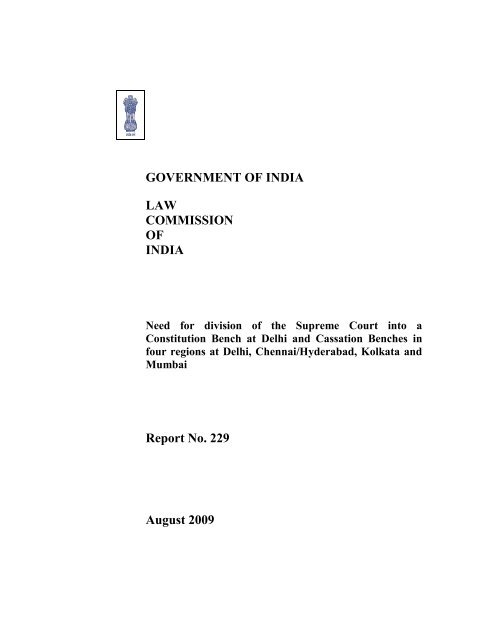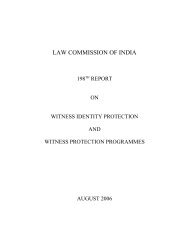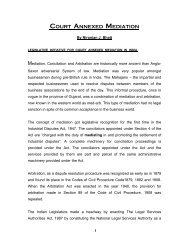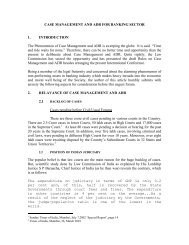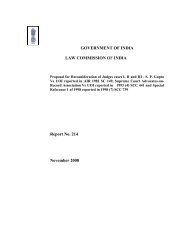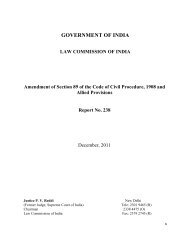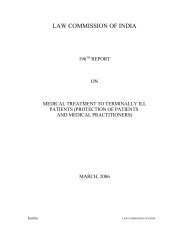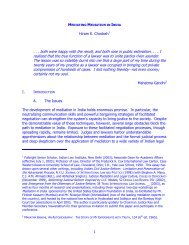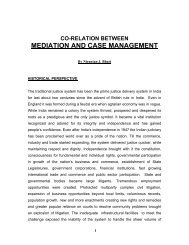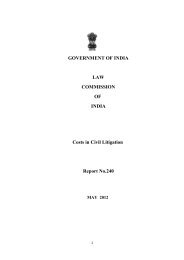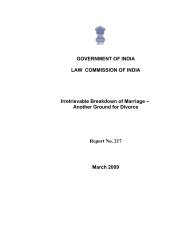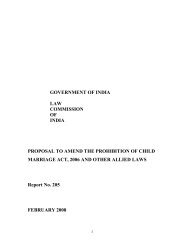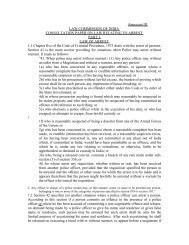229th Report - Law Commission of India
229th Report - Law Commission of India
229th Report - Law Commission of India
- No tags were found...
You also want an ePaper? Increase the reach of your titles
YUMPU automatically turns print PDFs into web optimized ePapers that Google loves.
The 18 th <strong>Law</strong> <strong>Commission</strong> was constituted for a period<strong>of</strong> three years from 1 st September, 2006 by Order No.A.45012/1/2006-Admn.III (LA) dated the 16 th October,2006, issued by the Government <strong>of</strong> <strong>India</strong>, Ministry <strong>of</strong><strong>Law</strong> and Justice, Department <strong>of</strong> Legal Affairs, NewDelhi.The <strong>Law</strong> <strong>Commission</strong> consists <strong>of</strong> the Chairman, theMember-Secretary, one full-time Member and sevenpart-time Members.ChairmanHon’ble Dr. Justice AR. LakshmananMember-SecretaryDr. Brahm A. AgrawalFull-time MemberPr<strong>of</strong>. Dr. Tahir MahmoodPart-time MembersDr. (Mrs.) Devinder Kumari RahejaDr. K. N. Chandrasekharan PillaiPr<strong>of</strong>. (Mrs.) Lakshmi JambholkarSmt. Kirti SinghShri Justice I. VenkatanarayanaShri O.P. SharmaDr. (Mrs.) Shyamlha Pappu3
The <strong>Law</strong> <strong>Commission</strong> is located in ILI Building,2 nd Floor, Bhagwan Das Road,New Delhi-110 001<strong>Law</strong> <strong>Commission</strong> StaffMember-SecretaryDr. Brahm A. AgrawalResearch StaffShri Sushil KumarMs. Pawan SharmaShri J. T. Sulaxan RaoShri A. K. UpadhyayDr. V. K. SinghDr. R. S. Shrinet: Joint Secretary& <strong>Law</strong> Officer: Additional <strong>Law</strong> Officer: Additional <strong>Law</strong> Officer: Deputy <strong>Law</strong> Officer: Assistant Legal Adviser: Superintendent (Legal)Administrative StaffShri Sushil KumarShri D. ChoudhuryShri S. K. BasuSmt. Rajni Sharma: Joint Secretary& <strong>Law</strong> Officer: Under Secretary: Section Officer: Assistant Library &Information Officer4
The text <strong>of</strong> this <strong>Report</strong> is available on the Internet at:http://www.lawcommission<strong>of</strong>india.nic.in© Government <strong>of</strong> <strong>India</strong><strong>Law</strong> <strong>Commission</strong> <strong>of</strong> <strong>India</strong>The text in this document (excluding the GovernmentLogo) may be reproduced free <strong>of</strong> charge in any formator medium provided that it is reproduced accuratelyand not used in a misleading context. The materialmust be acknowledged as Government copyright andthe title <strong>of</strong> the document specified.Any enquiries relating to this <strong>Report</strong> should beaddressed to the Member-Secretary and sent either bypost to the <strong>Law</strong> <strong>Commission</strong> <strong>of</strong> <strong>India</strong>, 2 nd Floor, ILIBuilding, Bhagwan Das Road, New Delhi-110001, <strong>India</strong>or by email to lci-dla@nic.in5
Dr. Justice AR. Lakshmanan(Former Judge, Supreme Court <strong>of</strong> <strong>India</strong>),Chairman, <strong>Law</strong> <strong>Commission</strong> <strong>of</strong> <strong>India</strong>ILI Building (IInd Floor)Bhagwandas Road,New Delhi – 110 001Tel. 91-11-23384475Fax. 91-11 – 23383564D.O. No. 6(3)/166 /2009-LC (LS) 5 August, 2009Dear Dr Veerappa Moily ji,Subject: Need for division <strong>of</strong> the Supreme Court into a ConstitutionBench at Delhi and Cassation Benches in four regions atDelhi, Chennai/Hyderabad, Kolkata and MumbaiI am forwarding herewith the 229 th <strong>Report</strong> <strong>of</strong> the <strong>Law</strong> <strong>Commission</strong><strong>of</strong> <strong>India</strong> on the above subject.2. Constitutional adjudication or determination <strong>of</strong> constitutionalcontroversies by the Supreme Court has its own importance. Thisincludes the authority to rule on whether or not laws that are challengedare in fact unconstitutional. All sorts <strong>of</strong> facts and their consequences, andthe values we attach to them, questions <strong>of</strong> economics, politics, socialpolicies etc. going beyond purely legal disputes, are for determination bythe Court.3. As constitutional adjudication occupies a place <strong>of</strong> its own, italways merits consideration as to whether there should be a separateconstitutional court, as is the position in about 55 countries <strong>of</strong> the world(Austria established the world’s first separate constitutional court in1920), or at least the Supreme Court should have a ConstitutionalDivision. Many continental countries have constitutional courts as well asfinal courts <strong>of</strong> appeal called courts <strong>of</strong> cassation (Cour de Cassation inFrench) for adjudication <strong>of</strong> non-constitutional matters. A court <strong>of</strong>cassation is the judicial court <strong>of</strong> last resort and has power to quash(casser in French) or reverse decisions <strong>of</strong> the inferior courts.4. We are today also in dire search for solution for the unbearableload <strong>of</strong> arrears under which our Supreme Court is functioning as well as6
Need for division <strong>of</strong> the Supreme Court into a ConstitutionBench at Delhi and Cassation Benches in four regions at Delhi,Chennai/Hyderabad, Kolkata and MumbaiContentsPage Nos.I. INTRODUCTION 9 - 11II. RECOMMENDATIONS AND VIEWS 12 - 19EXPRESSEDIII. BENCHES UNDER ARTICLE 130 20 - 23OF THE CONSTITUTIONIV. CONCLUSION AND RECOMMENDATION 24 - 25APPENDIX 26 - 288
I. INTRODUCTION1.1 Ever since the High Courts were founded in 1860, they were thehighest courts <strong>of</strong> appeal in each province (in the Chief <strong>Commission</strong>ers’Provinces the Judicial <strong>Commission</strong>er’s Courts were the highest courts <strong>of</strong>appellate jurisdiction) and an appeal lay from them to the Privy Councilin England. The Government <strong>of</strong> <strong>India</strong> Act 1935 created the FederalCourt <strong>of</strong> <strong>India</strong> with an original jurisdiction in disputes between theprovinces inter se and between the provinces and the federation. TheFederal Court had jurisdiction only in constitutional matters, but thefederal legislature could confer on the court the power to hear appeals incivil matters decided by the High Courts. The jurisdiction <strong>of</strong> the PrivyCouncil was abolished by the Abolition <strong>of</strong> the Privy Council JurisdictionAct 1949, the appeals pending before the Privy Council before October10, 1949, standing transferred to the Federal Court. Under ourConstitution, the Supreme Court <strong>of</strong> <strong>India</strong> became the highest court <strong>of</strong>appeal for the whole <strong>of</strong> <strong>India</strong>. Its jurisdiction is wider than that <strong>of</strong> anyFederal Supreme Court. It has original jurisdiction in disputes betweenthe Union and the States, and between the States inter se. It has originaljurisdiction under article 32 <strong>of</strong> the Constitution for the protection <strong>of</strong>fundamental rights. It is the highest court <strong>of</strong> civil and criminal appeal;and it has overriding powers to grant special leave to appeal from anyjudgment, decree, determination, sentence or order in any cause or matterpassed or made by any court or tribunal in the territory <strong>of</strong> <strong>India</strong> except acourt or tribunal constituted by or under any law relating to the Armed9
Forces. 1 It also has advisory jurisdiction under article 143 <strong>of</strong> theConstitution.1.2 Constitutional adjudication or determination <strong>of</strong> constitutionalcontroversies by the Supreme Court has its own importance. Thisincludes the authority to rule on whether or not laws that are challengedare in fact unconstitutional. All sorts <strong>of</strong> facts and their consequences, andthe values we attach to them, questions <strong>of</strong> economics, politics, socialpolicies etc. going beyond purely legal disputes, are for determination bythe Court.1.3 As constitutional adjudication occupies a place <strong>of</strong> its own, italways merits consideration as to whether there should be a separateconstitutional court, as is the position in about 55 countries 2 <strong>of</strong> the world(Austria established the world’s first separate constitutional court in1920), or at least the Supreme Court should have a ConstitutionalDivision. Many continental countries have constitutional courts as well asfinal courts <strong>of</strong> appeal called courts <strong>of</strong> cassation (Cour de Cassation inFrench) for adjudication <strong>of</strong> non-constitutional matters. A court <strong>of</strong>cassation is the judicial court <strong>of</strong> last resort and has power to quash(casser in French) or reverse decisions <strong>of</strong> the inferior courts.1.4 We are today in dire search for solution for the unbearable load <strong>of</strong>arrears under which our Supreme Court is functioning as well as the1H. M. Seervai, Constitutional <strong>Law</strong> <strong>of</strong> <strong>India</strong> – A Critical Commentary, 3 rd ed. (1984), Vol. 2, pages2181-21822For example, Central African Republic, Colombia, Egypt, France, Germany, Iran, Italy, Myanmar,Russia, South Africa10
unbearable cost <strong>of</strong> litigation for those living in far-flung areas <strong>of</strong> thecountry. The agonies <strong>of</strong> a litigant coming to New Delhi from distantplaces like Chennai, Thiruvananthapuram, Puducherry in the South,Gujarat, Maharashtra, Goa in the West, Assam or other States in the Eastto attend a case in the Supreme Court can be imagined; huge amount isspent on travel; bringing one’s own lawyer who has handled the matter inthe High Court adds to the cost; adjournment becomes prohibitive; costsget multiplied.1.5 Whether the Supreme Court should be split into ConstitutionalDivision and Legal Division for appeals, the latter with Benches in fourregions – North, South, East and West, is a subject <strong>of</strong> fundamentalimportance for the judicial system <strong>of</strong> the country. This <strong>Report</strong> considersthe question as to whether there is need for creating a ConstitutionalCourt or Division in our Supreme Court that shall exclusively deal withmatters <strong>of</strong> constitutional law and four Cassation Benches one each in thefour regions.11
II.RECOMMENDATIONS AND VIEWS EXPRESSED2.1 The tenth <strong>Law</strong> <strong>Commission</strong> in its 95 th <strong>Report</strong> titled “ConstitutionalDivision within the Supreme Court – A proposal for”, submitted in 1984,recommended that the Supreme Court <strong>of</strong> <strong>India</strong> should consist <strong>of</strong> twoDivisions, namely, (a) Constitutional Division, and (b) Legal Division.The proposed Constitutional Division <strong>of</strong> the Supreme Court should beentrusted with matters <strong>of</strong> constitutional law, i.e., every case involving asubstantial question <strong>of</strong> law as to the interpretation <strong>of</strong> the Constitution oran order or rule issued under the Constitution and every other caseinvolving a question <strong>of</strong> constitutional law. Other matters coming to theSupreme Court will be assigned to its Legal Division. It was furtherrecommended that judges appointed to the Supreme Court would, fromthe very beginning, be appointed to a particular division. For effectingthese recommendations, it was opined in the said <strong>Report</strong>, amendment <strong>of</strong>the Constitution would be necessary; ordinary legislation, vide article246(1) read with Entry 77 <strong>of</strong> the Union List or statutory rules, vide article145 <strong>of</strong> the Constitution would not be adequate.2.2 It may be noted that the tenth <strong>Law</strong> <strong>Commission</strong> had alsoconsidered the question as to whether there should be created aConstitutional Court to decide constitutional questions, instead <strong>of</strong> aConstitutional Division, but keeping in view that creation <strong>of</strong> a separateCourt for dealing with constitutional issues would involve structuralchanges <strong>of</strong> a more extensive and complex character than those that wouldbe necessitated by a proposal for creating, within the Supreme Court asstructured at present, separate divisions for dealing with constitutional12
and non-constitutional matters, as well as an overwhelming opinion infavour <strong>of</strong> a Constitutional Division, the <strong>Commission</strong> did not pursue theidea <strong>of</strong> creating a Constitutional Court.2.3 The eleventh <strong>Law</strong> <strong>Commission</strong> in its 125 th <strong>Report</strong> titled “TheSupreme Court – A Fresh Look”, submitted in 1988, reiterated the aboverecommendation for splitting the Supreme Court into two and gave anadditional reason for the same. The <strong>Commission</strong> stated the additionalreason in paragraph 4.17 <strong>of</strong> the said <strong>Report</strong> as under:“The Supreme Court sits at Delhi alone. Government <strong>of</strong> <strong>India</strong>, oncouple <strong>of</strong> occasions, sought the opinion <strong>of</strong> the Supreme Court <strong>of</strong><strong>India</strong> for setting up a Bench in the South. This proposal did notfind favour with the Supreme Court. The result is that thosecoming from distant places like Tamil Nadu in the South, Gujaratin the West and Assam and other States in the East have to spendhuge amount on travel to reach the Supreme Court. There is apractice <strong>of</strong> bringing one’s own lawyer who has handled the matterin the High Court to the Supreme Court. That adds to the cost.And an adjournment becomes prohibitive. Adjournment is arecurrent phenomenon in the Court. Costs get multiplied. Now ifthe Supreme Court is split into Constitutional Court and Court <strong>of</strong>Appeal or a Federal Court <strong>of</strong> Appeal, no serious exception couldbe taken to the Federal Court <strong>of</strong> Appeal sitting in Benches inplaces North, South, East, West and Central <strong>India</strong>. That would notonly considerably reduce costs but also the litigant will have theadvantage <strong>of</strong> his case being argued by the same advocate who hashelped him in the High Court and who may not be required totravel to long distances. Whenever questions <strong>of</strong> constitutionalityoccur, as pointed out in that report 3 , the Supreme Court can sit enbanc at Delhi and deal with the same. This cost benefit ratio is anadditional but important reason for reiterating support to therecommendations made in that report 4 .”395 th <strong>Report</strong> <strong>of</strong> the <strong>Law</strong> <strong>Commission</strong> <strong>of</strong> <strong>India</strong>4Ibid.13
2.4 The problem <strong>of</strong> delay in trial and disposal <strong>of</strong> cases and consequentpendency <strong>of</strong> cases in the apex court and the courts subordinate has been amatter <strong>of</strong> great concern, debate, discussion and criticism. The DepartmentRelated Parliamentary Standing Committee on Personnel, PublicGrievances, <strong>Law</strong> and Justice in its 28 th <strong>Report</strong> dealing with the SupremeCourt (Number <strong>of</strong> Judges) Amendment Bill 2008 has noted thus:“The Committee has felt that inordinate delay in delivering justiceto the people defeats the very purpose <strong>of</strong> the judiciary as aninstitution. The magnitude <strong>of</strong> the problem <strong>of</strong> the pendency <strong>of</strong> casesin various levels in the judiciary must be understood in the contextthat the people resort to judicial remedy as a last resort for theredressal <strong>of</strong> their grievances and to get justice. This is so becausepeople have reposed their ultimate faith and trust in the judicialsystem above the legislature and executive. In this contextpendency <strong>of</strong> cases hits the common man, seeking justice, thehardest. Perhaps, that is the reason that it is said justice delayed isjustice denied. However, in spite <strong>of</strong> the various measures taken bythe Government and the judiciary itself, it is a matter <strong>of</strong> seriousconcern that the pendency or arrears <strong>of</strong> cases has been increasingsteadily over the years bringing the judicial system as a whole tonear stagnation. Further, the pendency <strong>of</strong> cases in the SupremeCourt is very reflective <strong>of</strong> the delays in the judicial system, thus, acause <strong>of</strong> extreme concern requiring immediate remedial steps.”2.5 The background note <strong>of</strong> the Department <strong>of</strong> Justice on the Bill forincreasing number <strong>of</strong> Supreme Court Judges presented before theStanding Committee stated:“The Chief Justice <strong>of</strong> <strong>India</strong> has informed that there were 41,078cases pending in the Supreme Court as on 01.03.2007 and theJudges feel over-burdened and have been working under acutework pressure. He has further stated that despite satisfactory highrate <strong>of</strong> disposal, pendency <strong>of</strong> cases in the Supreme Court hasconstantly been on the rise due to comparatively higher rate <strong>of</strong>institution <strong>of</strong> cases. Pendency <strong>of</strong> cases in the courts could be14
directly ascribed to complex factors, with inadequate judgestrength coming at the top”.2.6 What has been stated before the Standing Committee is amplyproved by the fact that in 1950, there were 1,215 cases which wereinstituted (1,037 admission matters and 178 regular matters). Thedisposal rate was 525 (491 admission matters and 34 regular matters) andpendency <strong>of</strong> cases at the end <strong>of</strong> the year was 690 (546 admission casesand 144 regular cases). Therefore, as against 1,215 institutions, thedisposal <strong>of</strong> cases was 690 and the number <strong>of</strong> Judges was 7. In successiveyears, the number <strong>of</strong> Judges rose from 7 in 1950 to 10 in 1956, 13 in1960, 17 in 1977 and 25 in 1986 and now the strength <strong>of</strong> Judges in 2009is 30, excluding the Chief Justice <strong>of</strong> <strong>India</strong>. The total number <strong>of</strong> institution<strong>of</strong> cases from January to April in the year 2008 was 28,007 and thedisposal <strong>of</strong> cases was 28,559, i.e., 552 cases above the institution <strong>of</strong>cases. Yet the pendency <strong>of</strong> cases remained as 46,374. This clearly showsthat pendency <strong>of</strong> cases as accumulated over the years has also beencarried forward. In three years notably, i.e., 1989, 1990 and 1991 thependency-figure crossed over one lakh. The complete chart <strong>of</strong> institution,disposal and pendency <strong>of</strong> cases in the Supreme Court from the year 1950to April, 2008 is at Appendix.2.7 The said chart demonstrates that increase in number <strong>of</strong> Judges inthe apex court does not result in reduction <strong>of</strong> pending cases. It is,therefore, clear that there are reasons other than the inadequacy <strong>of</strong> judgestrengthwhich are responsible for accumulation <strong>of</strong> undecided cases in theSupreme Court.15
2.8 An important factor which needs to be kept in view is that in <strong>India</strong>,according to the <strong>Law</strong> <strong>Commission</strong>’s 120 th <strong>Report</strong> titled “ManpowerPlanning in Judiciary: A Blueprint”, submitted in 1987, the ratio betweenjudges and population is 10.5 judges per million (Shri Justice S. P.Bharucha, a former Chief Justice <strong>of</strong> <strong>India</strong>, in his <strong>Law</strong> Day address in2001 stated this figure to be 12 or 13), whereas it is 107 per million inUSA, 75.2 per million in Canada, 50.9 per million in U.K. and 41.6 permillion in Australia.2.9 It is, therefore, evident that the ratio between judges andpopulation is hopelessly low in our country. The same is apparent in theapex court as well since the Judges were 25 and the institution <strong>of</strong> caseswas 28,007 cases in January-April 2008. The ratio works out to 1: 112.The figure given above is <strong>of</strong> institution <strong>of</strong> new cases only. If the pendingarrears <strong>of</strong> 46,374 are taken into account, the ratio will be 1: 1855.2.10 Therefore, it is argued that the bench-strength <strong>of</strong> the SupremeCourt should be increased drastically to cover the backlog <strong>of</strong> pendingcases and to promote future developmental programmes in the judiciaryand thereby minimize delays in the justice-delivery system and promotespeedy justice which is the avowed goal <strong>of</strong> the Constitution. But it isequally effectively argued that mere increase in number <strong>of</strong> Judges mightnot help improve the system.2.11 Dr. P. C. Alexander, former Governor <strong>of</strong> Tamil Nadu andMaharashtra and Member <strong>of</strong> Parliament, has thrown considerable light on16
the malaise that ails the judicial system. In his article “Justice is pending”published in The Asian Age 5 Dr. Alexander has stated:“No doubt, increasing the number <strong>of</strong> judges, promptness in fillingup the vacancies and improving working facilities are all veryimportant for the efficiency <strong>of</strong> the judicial system, but these alonecannot be an adequate solution to the pendency problem. There aremany measures which the judiciary can take without waiting foradditional financial support from the government, but very littleeffective action has been taken on these by the judiciary and theycontinue to cause delays in the disposal <strong>of</strong> cases. They includelaxity shown by the courts in matters like production <strong>of</strong> witnesseson the dates posted for their examination, granting requests foradjournments <strong>of</strong> cases without good reasons, inordinate delays ingiving copies <strong>of</strong> documents, allowing lengthy arguments by theadvocates, and the practice <strong>of</strong> judges themselves writingunnecessarily long judgments.The liberal attitude <strong>of</strong> the courts in entertaining appeals from thelower courts has also contributed to the steady increase in thebacklog. Those who have the financial resources go on appeal onthe decisions <strong>of</strong> the lower courts to the next higher court, andfinally to the Supreme Court, even when no interpretation <strong>of</strong> thelaw may be involved. When the accused are influential politiciansor rich businessmen, the cases can go on endlessly, bringing downin this process the reputation <strong>of</strong> the judicial system itself. If appealscan be limited to a small number, say one or two, depending on thenature <strong>of</strong> the crime, it can help a great deal in reducing pendency.The practice <strong>of</strong> some judges in delaying the delivery <strong>of</strong> judgmentsfor several months, and in certain cases, even till they retire fromservice, has been another cause <strong>of</strong> delayed justice. Though amaximum time limit <strong>of</strong> one month has been considered reasonablefor the delivery <strong>of</strong> judgment, there is no mechanism forenforcement <strong>of</strong> any time limit, and this malpractice on the part <strong>of</strong>some judges thus goes on unchecked. Again, no serious attemptsare being made by the judiciary to make use <strong>of</strong> the provisions inthe Constitution for engaging the services <strong>of</strong> retired judges both atthe Supreme Court and at the High Courts for temporary periods5http://www.asianage.com, visited 22.07.200917
for help in clearing the backlog <strong>of</strong> cases. It appears that retiredjudges are reluctant to serve in this capacity as they consider suchservice not befitting their status. There is no reason why this issuecannot be sorted out to the satisfaction <strong>of</strong> the retired judges, but thejudiciary does not appear to be very keen about resorting to theseConstitutional provisions.”2.12 We have tried some <strong>of</strong> the above-mentioned measures for the last59 years <strong>of</strong> the functioning <strong>of</strong> the judicial system in our country. Theresult appears to be far from satisfactory. Time has come when the entirejudicial set-up will have to be overhauled and refurbished in order tomake the goal <strong>of</strong> speedy justice a pulsating reality. It is quite <strong>of</strong>ten arguedthat the present pattern <strong>of</strong> working <strong>of</strong> the Supreme Court needs to berevised if any success in this direction is to be achieved. Theindiscriminate acceptance <strong>of</strong> appeals on trivial issues <strong>of</strong> facts by theSupreme Court quite <strong>of</strong>ten overloads itself. In fact, only important issuesneed be litigated in the Supreme Court. Also, the present situation makesthe Supreme Court inaccessible to a majority <strong>of</strong> people in the country.2.13 In this context, it may be noted that in its 2 nd (2004), 6 th (2005) and15 th (2006) <strong>Report</strong>s the Parliamentary Standing Committee on <strong>Law</strong> andJustice has repeatedly suggested that in order to promote speedy justiceavailable to the common man, benches <strong>of</strong> the Supreme Court have to beestablished in the Southern, Western and North-Eastern parts <strong>of</strong> thecountry. In its 20 th (2007), 26 th (2008) and 28 th (2008) <strong>Report</strong>s, theStanding Committee suggested that a bench <strong>of</strong> the Supreme Courtshould be established at least in Chennai on trial basis as this would be <strong>of</strong>immense help to the poor who cannot travel from their native places to18
Delhi. Despite these <strong>Report</strong>s, the Hon’ble Supreme Court has so far notagreed with the suggestion regarding setting up <strong>of</strong> its benches.2.14 Paragraph 8.36 <strong>of</strong> the aforesaid 15 th <strong>Report</strong> reads as under:“The Committee is not satisfied with the persistent opposition forestablishing benches <strong>of</strong> the Supreme Court in other parts <strong>of</strong> thecountry without giving any convincing reasons or justificationthere<strong>of</strong>. The Committee, therefore, endorses its earlier view thatestablishment <strong>of</strong> benches <strong>of</strong> the Supreme Court in other parts <strong>of</strong>the country would be <strong>of</strong> immense help to the poor who can notafford to travel from their native places to Delhi. The Committee,therefore, feels that the Ministry should come forward with anecessary Constitutional amendment to address this deadlock.”2.15 Again, in paragraph 6.8 <strong>of</strong> the 28 th <strong>Report</strong> <strong>of</strong> the StandingCommittee, the same view has been reiterated in the following words:“The Committee in its Second, Sixth, Fifteenth, Twentieth andTwenty-sixth <strong>Report</strong>s on the Demands for Grants <strong>of</strong> the Ministry<strong>of</strong> <strong>Law</strong> and Justice has impressed upon for setting up <strong>of</strong> benches <strong>of</strong>the Supreme Court in Southern, Western and Eastern parts <strong>of</strong> thecountry. The Committee’s recommendation rests on the premisethat it is not possible for the people living in far-flung and remoteareas to come to the National Capital for seeking justice forvarious reasons. The Committee reiterates thisrecommendation.”19
III. BENCHES UNDER ARTICLE 130 OF THECONSTITUTIONCassation Benches in four zones3.1 A feasible, workable and efficient system <strong>of</strong> judicial administrationcould be established if <strong>India</strong> were to be divided into four zones/regions,namely, (I) Northern Zone – Bench to be established in Delhi dealingwith the litigation <strong>of</strong> the States <strong>of</strong> Uttar Pradesh, Uttarakhand, Rajasthan,Punjab, Haryana, Madhya Pradesh, Chhattisgarh, Himachal Pradesh,Jammu and Kashmir, the National Capital Territory <strong>of</strong> Delhi and theUnion territory <strong>of</strong> Chandigarh; (II) Southern Zone – Bench to beestablished in Chennai/Hyderabad in order to deal with the litigation <strong>of</strong>the States <strong>of</strong> Kerala, Tamil Nadu, Andhra Pradesh, Karnataka and theUnion territories <strong>of</strong> Puducherry and Lakshadweep; (III) Eastern Zone –Bench to be established in Kolkata dealing with the litigation <strong>of</strong> theStates <strong>of</strong> West Bengal, Bihar, Orissa, Jharkhand, Assam and the NortheasternStates including Sikkim and the Union territory <strong>of</strong> Andaman andNicobar Islands; (IV) Western Zone - Bench to be established at Mumbaidealing with the litigation <strong>of</strong> the States <strong>of</strong> Maharashtra, Gujarat, Goa andthe Union territories <strong>of</strong> Dadra and Nagar Haveli, and Daman and Diu.3.2 The said Benches shall act as Cassation Benches to deal withappeals from a High Court in the particular region. The apex court couldthen deal with constitutional issues and other cases <strong>of</strong> nationalimportance on a day to day basis since the accumulated backlog <strong>of</strong> caseswould go to the respective zones to which they pertain.20
Constitution Bench at Delhi3.3 The apex court would thus be relieved <strong>of</strong> the backlog <strong>of</strong>accumulated cases which are causing a burden and continuous strain onthe resources <strong>of</strong> the apex court. Since the accumulated cases pertaining toa particular region would be dealt with by the particular zonal bench, theapex court would be free to deal with only constitutional cases such asinterpretation <strong>of</strong> the Constitution, matters <strong>of</strong> national importance such asreferences made by the zonal benches to larger benches due to conflict <strong>of</strong>authority or any other reason, cases where the interests <strong>of</strong> more than oneState are involved such as interstate disputes on land, electricity, water,etc., references for advisory opinion made under article 143 <strong>of</strong> theConstitution, references made under article 317 <strong>of</strong> the Constitution,election petitions concerning Presidential and Vice-Presidential elections,suits between two or more States, etc. This list is merely illustrative andnot exhaustive.3.4 It is also suggested that all public interest litigations (PILs) fromany part <strong>of</strong> <strong>India</strong> should be decided by the apex Constitution Bench sothat there are no contradictory orders issued and also to arrest themushrooming <strong>of</strong> cases increasingly.3.5 The advantage <strong>of</strong> setting up <strong>of</strong> benches in the manner aforesaid isthat this can be made effective without any delay since the constitution <strong>of</strong>benches is a matter within the purview and jurisdiction 6 <strong>of</strong> the SupremeCourt itself under the Supreme Court Rules 1966.6Order VII, Supreme Court Rules 196621
3.6 Article 130 <strong>of</strong> the Constitution providing for the seat <strong>of</strong> theSupreme Court may now be noted, which is extracted below:“The Supreme Court shall sit in Delhi or in such other place orplaces, as the Chief Justice <strong>of</strong> <strong>India</strong> may, with the approval <strong>of</strong> thePresident, from time to time, appoint.”3.7 Article 130 is an enabling provision which empowers the ChiefJustice <strong>of</strong> <strong>India</strong>, with the approval <strong>of</strong> the President, to appoint place orplaces other than Delhi as the seat <strong>of</strong> the Supreme Court. Article 130cannot be construed as casting a mandatory obligation on the ChiefJustice <strong>of</strong> <strong>India</strong> to appoint place or places other than Delhi as the seat <strong>of</strong>the Supreme Court. No court can give a direction either to the ChiefJustice <strong>of</strong> <strong>India</strong> or the President to exercise the power under article 130. 73.8 If article 130 is liberally interpreted, no constitutional amendmentmay be required for the purpose <strong>of</strong> setting up <strong>of</strong> Cassation Benches infour regions and a Constitution Bench at Delhi. Action by the ChiefJustice <strong>of</strong> <strong>India</strong> with the President’s approval may be enough. It may alsobe noted that under article 130 the Chief Justice <strong>of</strong> <strong>India</strong> acts as apersona designata and is not required to consult any otherauthority/person. Only Presidential approval is necessary. However, incase this liberal interpretation <strong>of</strong> article 130 is not feasible, suitablelegislation/Constitutional amendment may be enacted to do the needful.3.9 If the judge-strength <strong>of</strong> each zonal Cassation Bench is confined tosix Judges, then only 24 Judges will be required for all the four zones to7Union <strong>of</strong> <strong>India</strong> v. S. P. Anand, AIR 1998 SC 261522
constitute Cassation Benches all over <strong>India</strong>. The other Judges will beavailable in the apex court, which will have a Constitution Bench atDelhi working on a regular basis.IV.CONCLUSION AND RECOMMENDATION23
4.1 The concept <strong>of</strong> having a Constitution Bench along with a CassationBench is nothing new. The democratic transition that occurred in manyparts <strong>of</strong> the world in the late 20 th century resulted in the proliferation <strong>of</strong>courts with constitutional adjudication and powers <strong>of</strong> cassation beingexercised simultaneously; there is a blend <strong>of</strong> functions <strong>of</strong> judicial reviewusually by the constitutional court or constitutional tribunal and also theexercise <strong>of</strong> powers <strong>of</strong> cassation. Italy has a Constitutional Court with thesole power <strong>of</strong> constitutional review and a Supreme Court <strong>of</strong> Cassationwith the power to review the decisions <strong>of</strong> the ordinary courts forconsistency with the law. Egypt also maintains a Court <strong>of</strong> Cassation thatmonitors the uniformity <strong>of</strong> lower court fidelity to the law but only itsSupreme Constitutional Court has the authority to declare lawsunconstitutional and to determine and rule upon legislative intent.Portugal’s Constitutional Tribunal has the greatest jurisdiction exercisingboth concrete review <strong>of</strong> lower court decisions and abstract review <strong>of</strong> alllaws and legal norms. Other countries which blend the functions <strong>of</strong>judicial review and cassation or the review <strong>of</strong> lower court decisions areIreland, the United States and Denmark.4.2 It is, therefore, recommended that:[1] A Constitution Bench be set up at Delhi to deal withconstitutional and other allied issues as aforesaid.[2] Four Cassation Benches be set up in the Northern region/zoneat Delhi, the Southern region/zone at Chennai/Hyderabad, theEastern region/zone at Kolkata and the Western region/zone at24
Mumbai to deal with all appellate work arising out <strong>of</strong> theorders/judgments <strong>of</strong> the High Courts <strong>of</strong> the particular region.[3] If it is found that article 130 <strong>of</strong> the Constitution cannot bestretched to make it possible to implement the aboverecommendations, Parliament should enact a suitablelegislation/Constitutional amendment for this purpose.4.3 We further recommend that with a view to reducing the heavybacklog <strong>of</strong> cases in the higher courts and meet the problem <strong>of</strong> findingsuitable persons for appointment <strong>of</strong> judges in these courts, theretirement age for the Supreme Court and High Court Judges be raisedto 70 and 65 years, respectively.(Dr Justice AR. Lakshmanan)Chairman(Pr<strong>of</strong>. Dr Tahir Mahmood)(Dr Brahm A. Agrawal)Member Member-Secretary25


